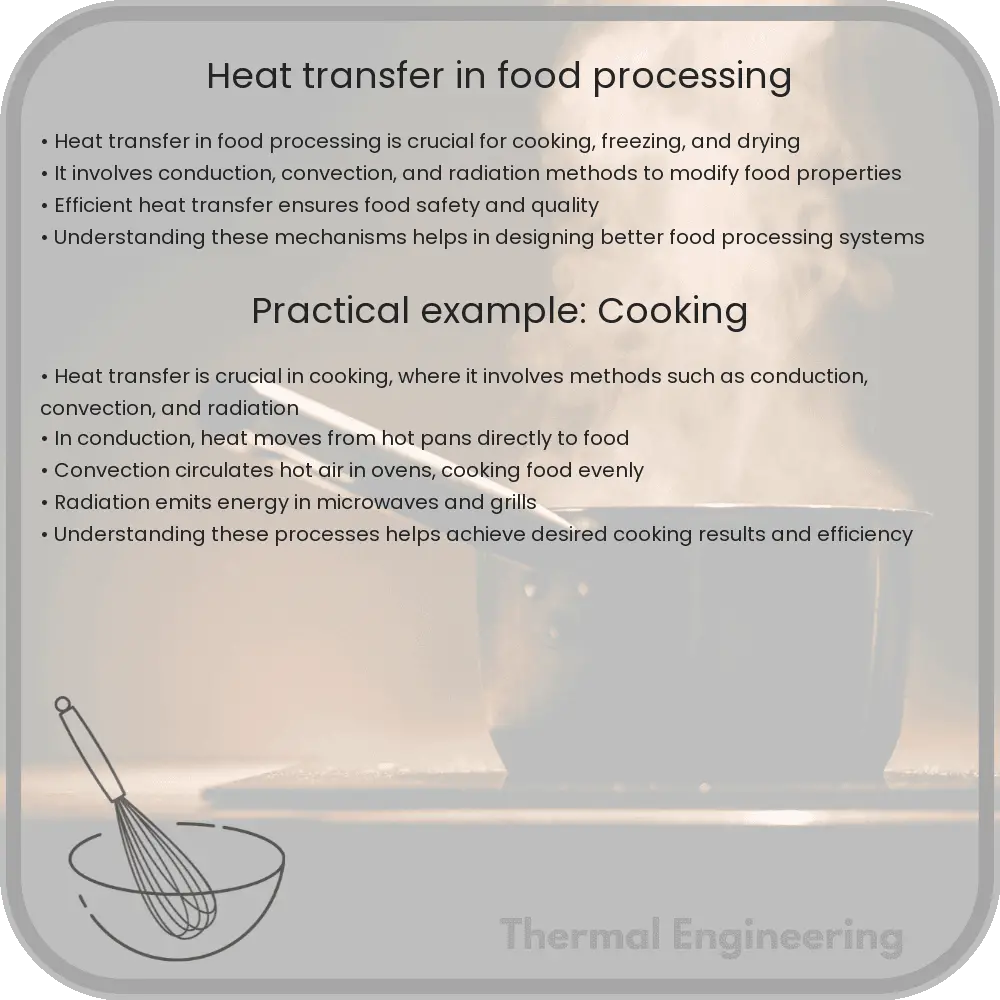Learn about heat transfer in food processing, including its types, mathematical principles, applications, and challenges in the industry.

Understanding Heat Transfer in Food Processing
Heat transfer is a fundamental aspect of food processing that affects everything from the safety and quality of food to its shelf-life and sensory attributes. Food engineers harness the principles of heat transfer to design processes that efficiently produce high-quality food products. This article will explore these principles and their practical applications in food processing.
Types of Heat Transfer
There are three primary modes of heat transfer utilized in the food processing industry: conduction, convection, and radiation.
- Conduction is the transfer of heat through a solid material. In food processing, conduction occurs when heat moves from a hot pan to its cooler contents, like when cooking a steak on a grill.
- Convection involves the transfer of heat by the physical movement of a fluid (either liquid or gas). This can be natural, as with the rising heat in a roasting oven, or forced, as in a convection oven where fans circulate the air.
- Radiation refers to heat transfer through electromagnetic waves. It doesn’t require a medium; for example, infrared heat lamps used to keep food warm operate via radiant heat transfer.
Mathematical Representation of Heat Transfer
In the engineering of food processing systems, understanding the mathematical description of how heat transfer occurs is crucial for designing efficient processes. The basic equation governing heat transfer is expressed as:
Q = k * A * (T1 – T2) / d
Where:
- Q is the rate of heat transfer (in watts, W)
- k represents the thermal conductivity of the material (in watts per meter-kelvin, W/m*K)
- A is the cross-sectional area through which heat is being transferred (in square meters, m2)
- T1 – T2 is the temperature difference between the hot and cold sides (in Kelvin, K)
- d is the thickness of the material (in meters, m)
These principles enable engineers to calculate how quickly heat needs to be transferred in a process to achieve desired food safety and quality objectives.
Applications of Heat Transfer in Food Processing
Heat transfer plays a role in numerous food processing applications:
- Pasteurization and Sterilization: These processes use heat to destroy pathogens and spoilage organisms in foods like milk, canned goods, and ready-to-eat meals. Engineers must understand heat transfer to ensure products are safe without compromising quality.
- Baking and Drying: Efficiently removing moisture from products such as bread, cookies, and dried fruits involves understanding how heat is transferred within an oven or dryer.
- Cooling and Freezing: Quickly reducing the temperature of food products to preserve quality and extend shelf life requires the removal of heat, which is a reverse application of heat transfer principles.
Each application uses specific machinery designed with an understanding of heat transfer dynamics, optimizing the balance between energy use, processing time, and product quality.
Challenges in Heat Transfer
Despite its importance, optimizing heat transfer in food processing presents several challenges:
- Scale-Up: Processes developed at a small scale do not always perform the same way when scaled up to industrial volumes, requiring careful recalibration of heat transfer parameters.
- Uneven Heating: Achieving uniform heat distribution can be difficult, especially in products of irregular shape and size, potentially leading to quality issues.
- Energy Efficiency: The cost and environmental impact of energy consumption in food processing drives the need for more efficient heat transfer processes.
Understanding and optimizing heat transfer in food processing technology is key to improving food safety, quality, and sustainability. Advances in this field continue to enhance the capabilities and efficiency of food processing operations worldwide.